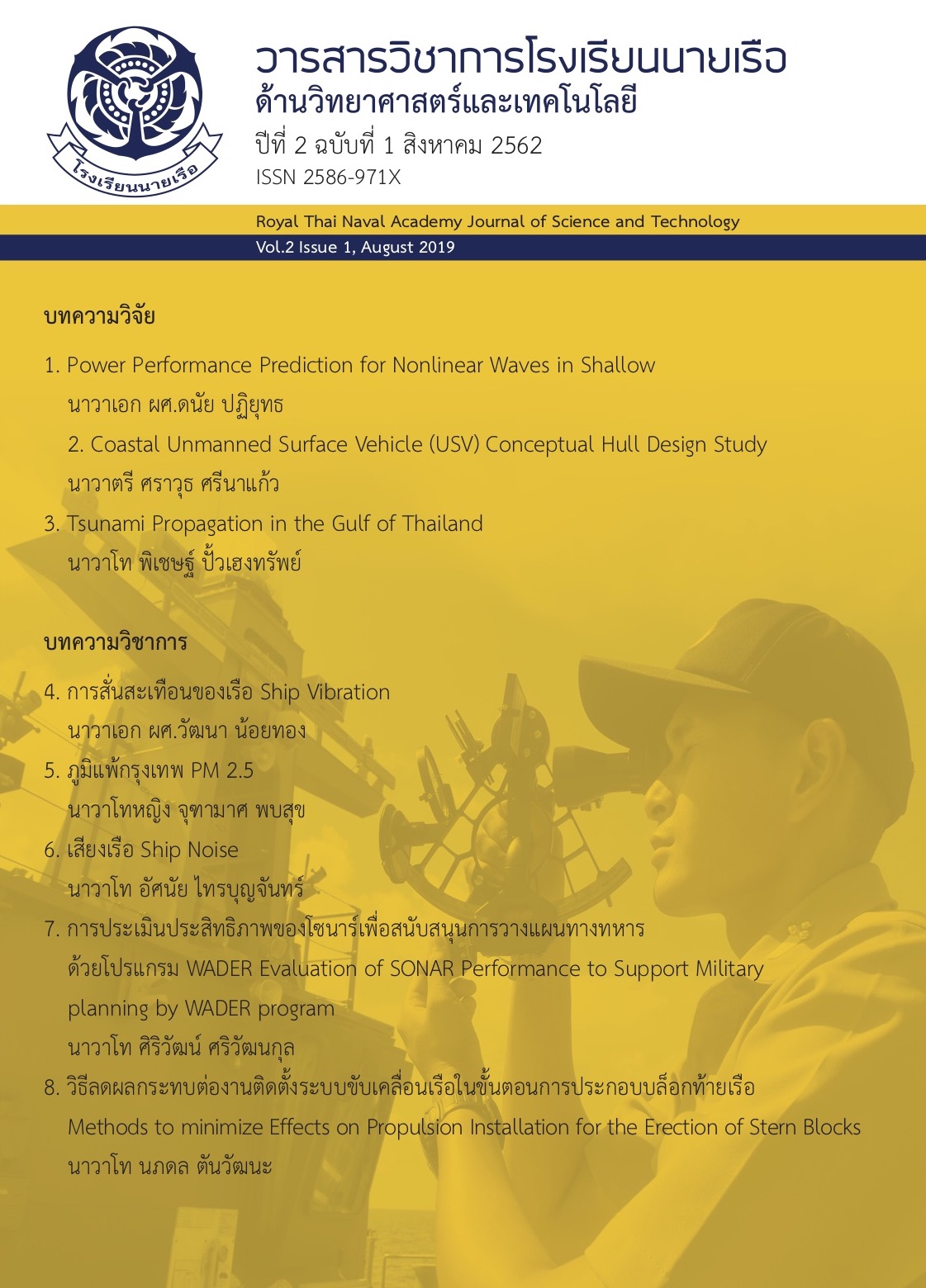Tsunami Propagation in the Gulf of Thailand
Main Article Content
บทคัดย่อ
The earthquake off the west coast of Thailand on December 26, 2004 and the subsequent tsunami disaster has focused research interests among scientists. The research is not solely focused on the west coast of Thailand, but also the east coast. The reason for the research is that the Thailand’s east coast is adjacent to China Sea, a part of the Pacific Ocean where earthquakes and volcanic eruptions are frequent. In addition, coastal elevation on the Thailand’s east coast is generally low, thus making it extremely vulnerable to wave inundation with a height of a few meters. The Manila Trench is an excellent candidate to assess the risk of tsunami impact to the east coast of Thailand due to its close proximity. This study creates a hypothetical earthquake tsunami scenario caused by sudden movement of seafloor at the Manila Trench. Tsunami travel time will be strictly observed because it is the most critical information for tsunami warning. The time will be determined by numerically solving the shallow - water equation. The study reveals that tsunami reaches the southern part of Thailand 11.42 hours and reaches Bangkok 17.73 hours after an earthquake. The probability of tsunami generated by the Manila Trench is unlikely to result in loss of human life along Thailand’s east coast due to the long travel time of the tsunami wave. The slower wave speed in the Gulf of Thailand allows time to evacuate people away from the coastal zone.
Article Details
เนื้อหาและข้อมูลในบทความที่ลงตีพิมพ์ในวารสารวิชาการโรงเรียนนายเรือ ด้านวิทยาศาสตร์และเทคโนโลยี ถือเป็นข้อคิดเห็นและความรับผิดชอบของผู้เขียนบทความโดยตรง ซึ่งกองบรรณาธิการวารสาร ไม่จำเป็นต้องเห็นด้วย หรือร่วมรับผิดชอบใด ๆ
บทความ ข้อมูล เนื้อหา รูปภาพ ฯลฯ ที่ได้รับการตีพิมพ์ในวารสารวิชาการโรงเรียนนายเรือ ด้านวิทยาศาสตร์และเทคโนโลยี ถือเป็นลิขสิทธิ์ของโรงเรียนนายเรือ หากบุคคลหรือหน่วยงานใดต้องการนำทั้งหมดหรือส่วนหนึ่งส่วนใดไปเผยแพร่ต่อหรือเพื่อกระทำการใด ๆ จะต้องได้รับอนุญาตเป็นลายลักษณ์อักษรจากโรงเรียนนายเรือก่อนเท่านั้น
เอกสารอ้างอิง
Chowdhury Shyamal, et al., 2005. Tsunami Hazards, FEMA Coastal Flood Hazard, Analysis and Mapping Guidelines, Focused Study Report, 42p.
Chadha, R.K. 2006. Tsunami Sources in the Indian Ocean: Factors and Impact on the Indian Landmass. The Indian Ocean Tsunami, p.33-38.
Geoffrey Blewitt, et al., 2006. Rapid Determination of Earthquake Magnitude using GPS for Tsunami Warning Systems. Retrieved October 31, 2016 from https://www.earth.northwestern.edu/individ/seth/Texts/gpswarning.pdf
Integrated Tsunami Database for the World Ocean (WinITDB Project): Tsunami Laboratory. Retrieved November 5, 2016 from https://tsun.sscc.ru/tsun_hp.htm
Kirby, S., Geist, E., Lee, W.H.K., Scholl, D., Blakely, R., 2006. Tsunami Source Characterization for Western Pacific Subduction Zones: a preliminary report. In: USGS Tsunami Sources Workshop 2006. Houston, TX.
Robinson, Margaret K., 1974. The physical oceanography of the Gulf of Thailand, Naga Expedition; Bathythermograph (BT) temperature observations in the Timor sea, Naga Expedition, Cruise S11, Scripps Institution of Oceanography, 125p.
Ruangrassamee A. and Saelem N., 2009. Effect of Tsunamis generated in the Manila Trench on the Gulg of Thailand, Journal of Asian Earth Sciences 36, p.55-56
Susan L. Bilek, Kenji Satake and Kerry Sieh, 2007. Introduction to Special Issue on the 2004 Sumatra – Andaman Earthquake and the Indian Ocean Tsunami. Bulletin of the Seismological Society of America, Vol.97, No. 1A, doi: 10.1785/0210050633, p. s1-s5
Siripong A., 2010. Detect Coastline Changes in Thailand by remote sensing, International Archives of the Photogrammetry, remote Sensing and Spatial Information Science, Volume XXXVIII, Part 8, Kyoto, Japan. P.992-995.
The Open University, 1999. Waves, Tides and Shallow – Water Processes, second edition, Butterworth – Heinemann, Oxford, 227 p.
The Accident Investigation Board Finland, 2004. Investigation Report (A 2/2004 Y): The Natural Disaster in Asia on 26 December 2004, 226 p.
United States Geological Survey (USGS): Earthquake Facts. Retrieved November 1, 2016 from https://earthquake.usgs.gov/learn/facts.php
Wattayakorn, G., 2006. Environmental Issues in the Gulf of Thailand, ResearchGate, Ch.16, doi: 10.1007/1-4020-3655-8-16, 12 p. Retrieved November 8, 2016 from https://www.researchgate. net/publication/227211647_Environmental_Issues_in_the_Gulf_of_Thailand
Wu, T.-R., Huang and H.-C., 2009. Modeling Tsunamis Hazards from the Manila Trench to Taiwan, Journal of Asian Earth Sciences 36, p.21-28


